Isleta Pueblo Painting Houses on a Hill by Ed Jojola - Shirpoyo - C3872
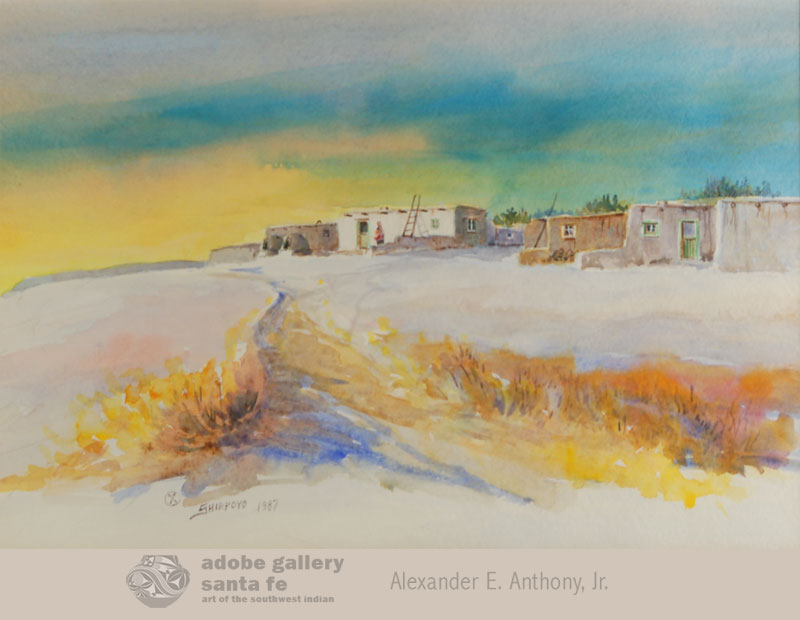 Some of Shirpoyo's exhibits were with the Santa Fe Indian Market, Colorado Indian Market, Glenwood Springs Fall Arts Festival, Colorado, and New Mexico State University. He was featured in articles in the Denver Post, Albuquerque Journal, and Dallas News, along with various travel section magazines throughout the United States.
Some of Shirpoyo's exhibits were with the Santa Fe Indian Market, Colorado Indian Market, Glenwood Springs Fall Arts Festival, Colorado, and New Mexico State University. He was featured in articles in the Denver Post, Albuquerque Journal, and Dallas News, along with various travel section magazines throughout the United States.
Many of Shirpoyo's paintings are owned by patrons throughout the United States as well as Canada, England, France, Germany, Australia, Switzerland, and South America, to name a few. It was with much pleasure that we accepted this large watercolor brought to us by a resident of Santa Fe.
Shirpoyo basically painted scenes in and around his village of Isleta Pueblo. This watercolor features a couple of adobe houses on a hilltop at the pueblo. There are ladders leaning against the buildings, horno ovens outside in the yard, and a female in colorful clothing heading toward one of the houses. The foreground is awash in beautiful fall colors as the native grasses began their annual sleep.
Original Painting Entitled Swallow Dancer by Po-qui-Tsireh - 25937
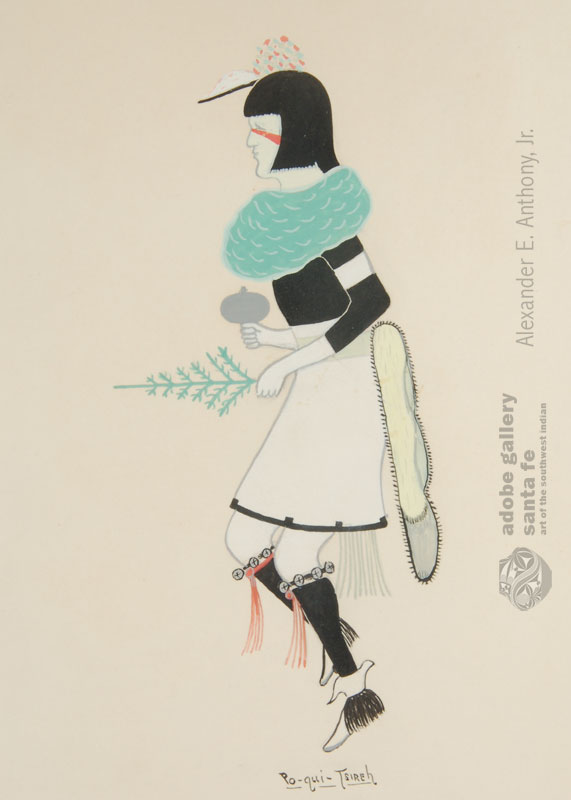 Identity of early 20th-century Native artists is not always documented in the standard reference books but sometime can be uncovered in more unusual places. There is no mention of Tomacito Vigil (c.1923-) Po-qui-Tsireh in any of the published books on Native artists that we have consulted, however, his name appears in a PhD Dissertation to the University of Texas, Austin, in 2011. It is simply a line entry with his name and that he attended the Santa Fe Indian School in 1936-37.
Identity of early 20th-century Native artists is not always documented in the standard reference books but sometime can be uncovered in more unusual places. There is no mention of Tomacito Vigil (c.1923-) Po-qui-Tsireh in any of the published books on Native artists that we have consulted, however, his name appears in a PhD Dissertation to the University of Texas, Austin, in 2011. It is simply a line entry with his name and that he attended the Santa Fe Indian School in 1936-37.
The Original Painting Entitled Swallow Dancer is marked on verso: "Swallow Dancer" by Tomacito Vigil, age 13, San Ildefonso Pueblo. It is signed in center right on the front Po-qui-Tsireh, his Tewa name. It is a single figure dancer with no background design, in typical fashion of The Studio of the Santa Fe Indian School. The dancer has a large green ruff around his neck, black body paint, white kilt with a fox tail, black stockings, and white moccasins.
San Ildefonso Pueblo Polychrome Jar with Red Rim - SC3680F
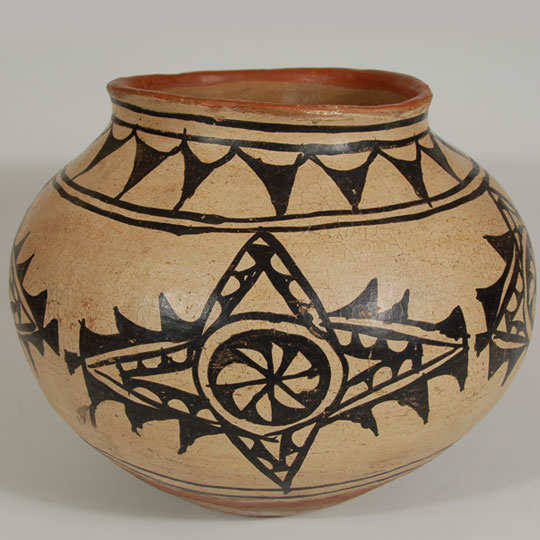 Tesuque and San Ildefonso Pueblo are somewhat neighbors. The people speak the same language and their historic pottery is similar in shape and design. It is sometimes difficult to make the determination which pueblo was responsible for a specific jar. Batkin (see reference), stated that collections made at Tesuque in the 1870 to 1880 period showed that the designs were of recent evolution. Is it likely that Tesuque potters styled their designs on those seen at San Ildefonso? Of course, we will never know for sure but it is quite possible that was the sequence.
Tesuque and San Ildefonso Pueblo are somewhat neighbors. The people speak the same language and their historic pottery is similar in shape and design. It is sometimes difficult to make the determination which pueblo was responsible for a specific jar. Batkin (see reference), stated that collections made at Tesuque in the 1870 to 1880 period showed that the designs were of recent evolution. Is it likely that Tesuque potters styled their designs on those seen at San Ildefonso? Of course, we will never know for sure but it is quite possible that was the sequence.
San Ildefonso switched from its traditional cream slip, that required stone polishing, to the bentonite slip used by Cochiti Pueblo potters, around 1905. Tesuque switched also, but probably did not start to do so until a decade later and some potters did not change until the 1940s. Potters at San Ildefonso began changing the color of the rim from red to black as early as 1897. Tesuque potters switched rim color from red to black in the 1880s.
Male and Female Pair of Cochiti Pueblo Squash Dancers by Quah Ah - C3868L
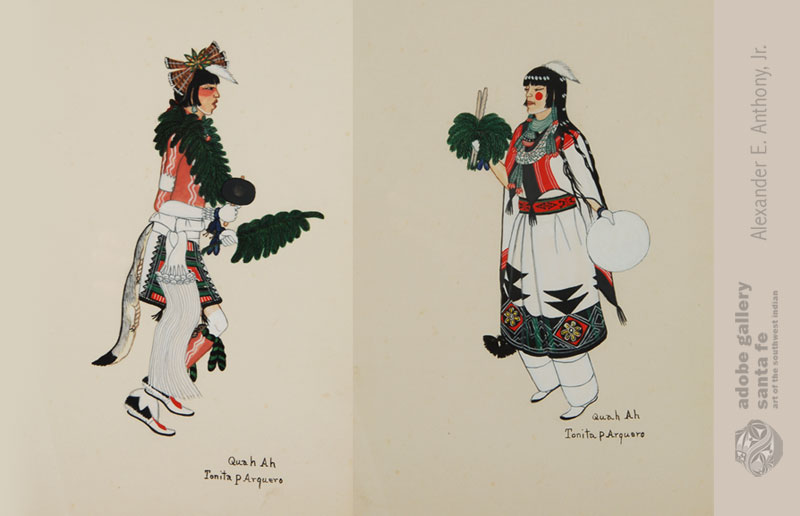 A few of Tonita Vigil Peña (1893-1949) Quah Ah's works, painted in 1922 and 1923, were signed:
A few of Tonita Vigil Peña (1893-1949) Quah Ah's works, painted in 1922 and 1923, were signed:
Tonita P. Arquero
as on this Male and Female Pair of Cochiti Pueblo Squash Dancers, in honor of her husband, Epitacio Arquero. This signature is quite rare.
Tonita Peña labeled each of these paintings on verso Cochiti Pueblo Squash Dance $5.00. Whether the Squash Dance is still being performed a hundred years after these paintings were completed is not publicly known.
Navajo Squash Blossom Necklace with U S Coins - C3871
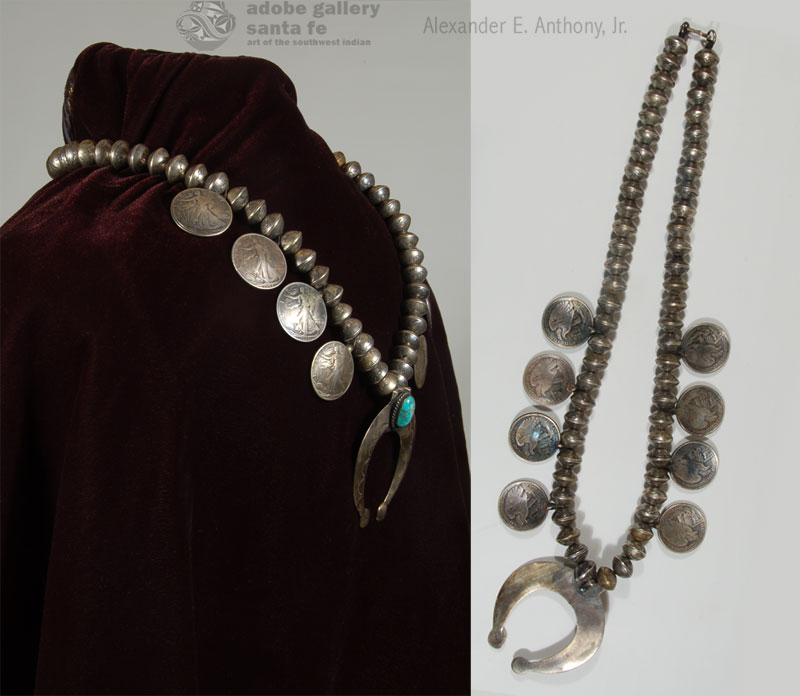 It was ingenious of some unknown Native artist to create a squash blossom necklace using repurposed materials-United States dimes and half dollars. I do not know who was the first to do so or exactly when the first one was made, but it was probably in the late 1970s. Supposedly it is illegal to deface United States coins but that did not stop the creation of this and other similar necklaces.
It was ingenious of some unknown Native artist to create a squash blossom necklace using repurposed materials-United States dimes and half dollars. I do not know who was the first to do so or exactly when the first one was made, but it was probably in the late 1970s. Supposedly it is illegal to deface United States coins but that did not stop the creation of this and other similar necklaces.
Each bead in the Navajo Squash Blossom Necklace with U S Coins was made by forming two United States dime coins into hemispheres and then soldering them together, drilling them in their center, and stringing them for a necklace.
Historic Acoma Pueblo Polychrome Olla with Zuni Pueblo Designs - 25164
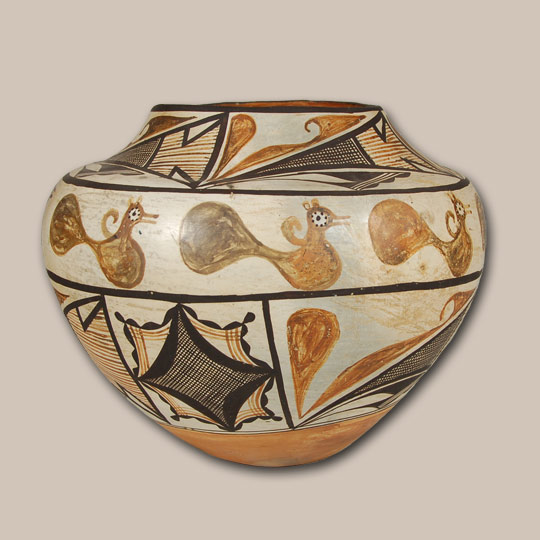 This early 1900s Acoma olla was decorated in its entirety in Zuni designs. For over a hundred years, Acoma potters have borrowed and reproduced Zuni designs. This trend seemed to be favorable in the 1890 to 1915 time period. Designs moved rather freely between Zuni and Acoma, no doubt due to their geographical proximity and probable historic connections.
This early 1900s Acoma olla was decorated in its entirety in Zuni designs. For over a hundred years, Acoma potters have borrowed and reproduced Zuni designs. This trend seemed to be favorable in the 1890 to 1915 time period. Designs moved rather freely between Zuni and Acoma, no doubt due to their geographical proximity and probable historic connections.
Acoma Pueblo Hawikuh Style Olla, circa 1920s by Dolores Estevan Ascencion - C3123
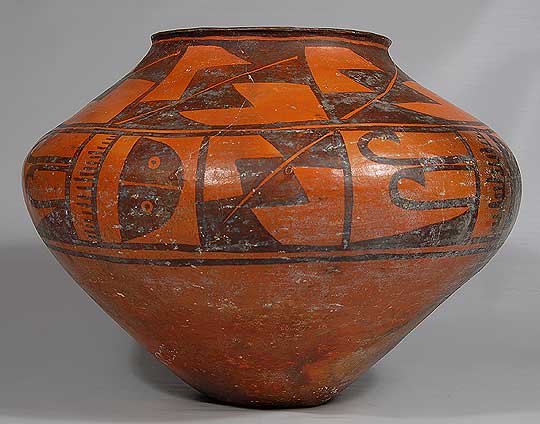 "Dolores Estevan Ascencion was married to Juan Estevan Ascencion; they had one daughter, Lita. A woman named Juana Dolores Estevan, who may have been the same person, was enumerated in the 1910 Federal census and identified as a pottery maker; she was the mother of Juana Maria Yousiewa, wife of Juan Estevan Yousiewa.
"Dolores Estevan Ascencion was married to Juan Estevan Ascencion; they had one daughter, Lita. A woman named Juana Dolores Estevan, who may have been the same person, was enumerated in the 1910 Federal census and identified as a pottery maker; she was the mother of Juana Maria Yousiewa, wife of Juan Estevan Yousiewa.
"The authors know of four examples of pottery identified as the work of Dolores Ascencion. One, a black-on-red jar was purchased by Kenneth M. Chapman at Acoma in 1928; his record indicates it was made by Dolores Ascension. This jar is in the SAR collection (IAF.1031). The same jar however, was identified as the work of Santana Sanchez by Marie Z. Chino in 1963. It is a copy of a Hawikuh glaze-on-red dating from about 1670 in the SAR collection (IAF.996), which Dr. Harry P. Mera purchased from Dolores Ascencion, also in 1928). Chapman may have commissioned the copy. A closely similar jar by Ascencion is in the MIAC collection (7757/12); it also has matte white pigment in the decoration.
Historic Acoma Pueblo Polychrome Jar with Unusual Birds - 25898
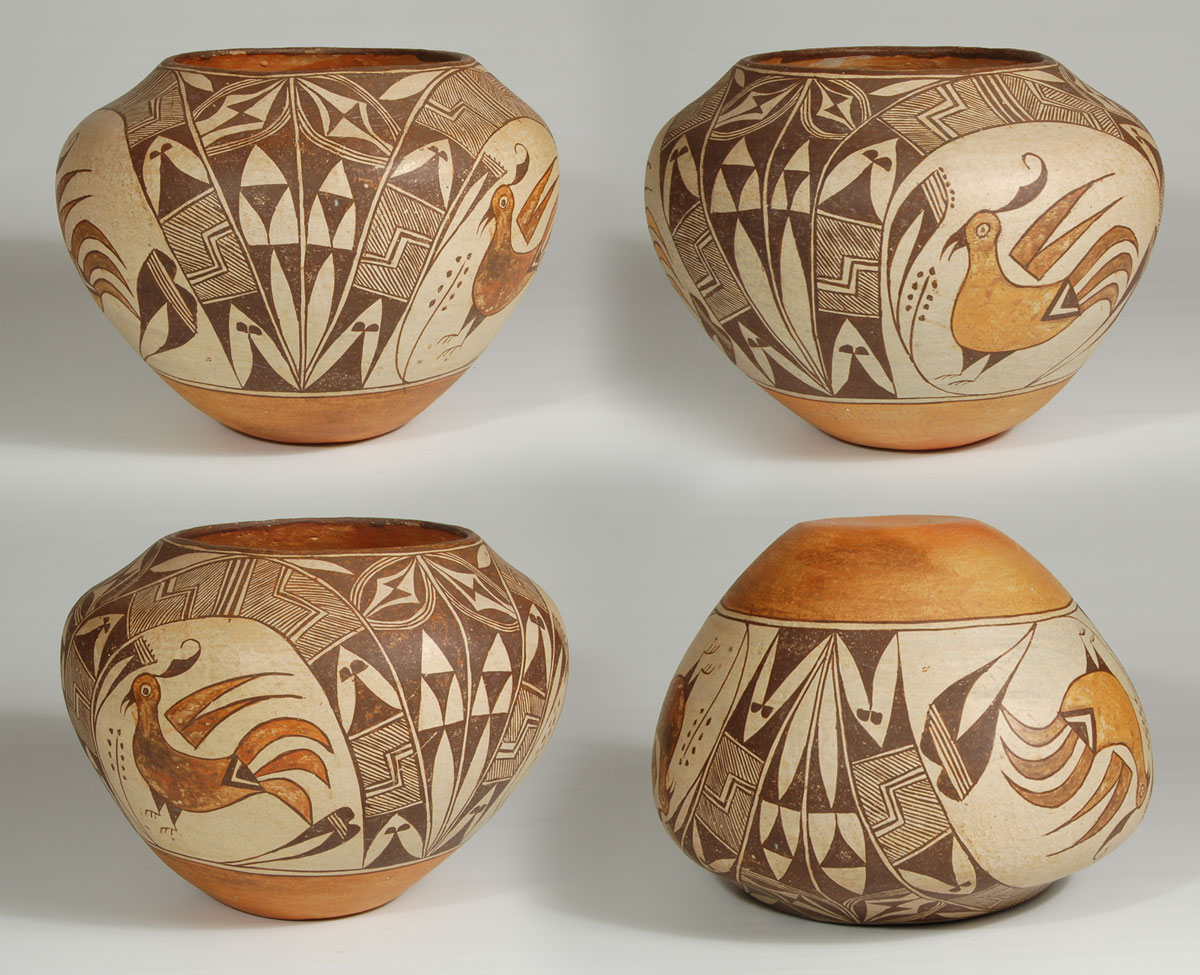 Acoma potters generally present a design in one of two different manners. One is to use the entire vessel as a single canvas with no distinction between the rim, shoulder and body of the vessel, that is, the design expands over the shoulder and to the rim without divination. The other manner is to draw a framing line at the shoulder and then treat the neck design and body design as separate entities.
Acoma potters generally present a design in one of two different manners. One is to use the entire vessel as a single canvas with no distinction between the rim, shoulder and body of the vessel, that is, the design expands over the shoulder and to the rim without divination. The other manner is to draw a framing line at the shoulder and then treat the neck design and body design as separate entities.
This jar has a design covering the entire surface with no division at the shoulder. There are basically two design styles to this jar. All of the elements in brown constitute the design in geometric terms-triangles, scrolls, rectangles, circles and lines. The other design features birds presented in orange slip, outlined in brown. Most often, Acoma birds used on pottery are parrots, but this potter chose a beaked bird with a fancy top knot on its head and wings that are separated completely from the body. If one searched thoroughly it might be possible to find documented examples of a bird of this style but I have not before seen one with the wings completely separated from the body.
Navajo Double Bar Silver and Five Turquoise Cabs Bracelet - C3864.04
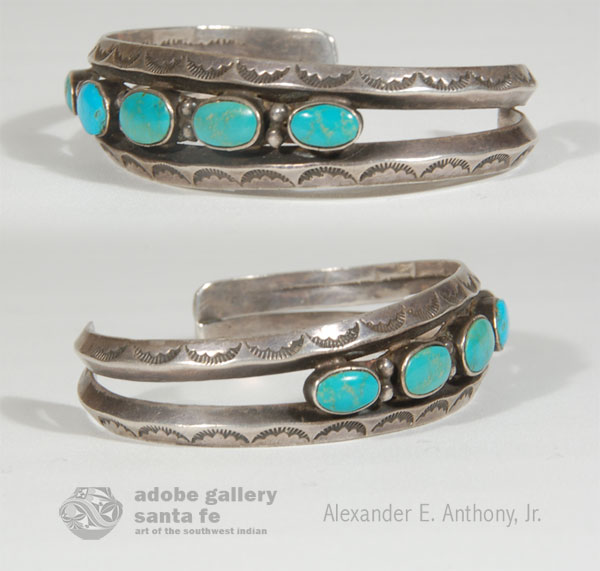 The foundation of this bracelet is made from a pair of triangular-shaped silver bars, spaced apart, connected at the ends, and stamped with traditional images. At the top center of the bracelet are five oval shaped natural turquoise cabs, varying from blue to slightly green in color. Each cab is set in a handmade silver bezel. The five settings are separated by pairs of silver dots.
The foundation of this bracelet is made from a pair of triangular-shaped silver bars, spaced apart, connected at the ends, and stamped with traditional images. At the top center of the bracelet are five oval shaped natural turquoise cabs, varying from blue to slightly green in color. Each cab is set in a handmade silver bezel. The five settings are separated by pairs of silver dots.
The bracelet is inscribed with the name J. Chee, but I have not located an artisan with that name, presented in that arrangement, in any of the published references.
Acoma Pueblo Polychrome Canteen with Corncob Stopper by Eva Histia - 24718
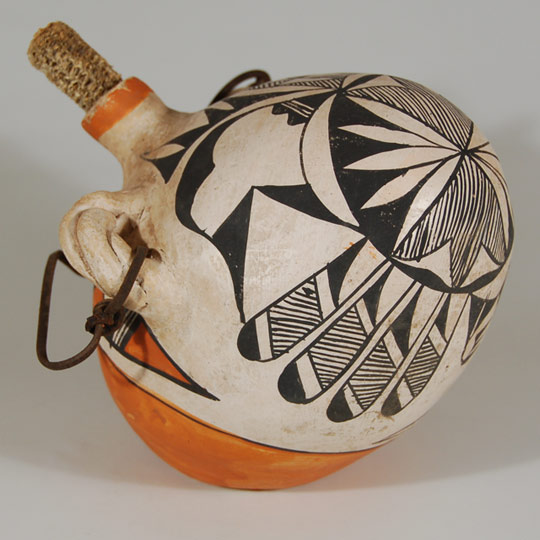 This is a most unusual and most spectacular canteen, built, I believe, for actual use by its owner while working in the fields. It is very difficult to date this piece of pottery because I have never seen a documented one of the same vessel shape. Seen from profile, this one has an egg-like shape. I would estimate it to be from the early 20th century.
This is a most unusual and most spectacular canteen, built, I believe, for actual use by its owner while working in the fields. It is very difficult to date this piece of pottery because I have never seen a documented one of the same vessel shape. Seen from profile, this one has an egg-like shape. I would estimate it to be from the early 20th century.
The traditional Acoma features are all present: coarse, white paste of a distinctly chunky texture, pottery shards for temper, orange-red underbody paint and rag-wiped white slip. The decoration is a full version of a bird. Notice the head on the upper right, the legs at lower right, and tail feathers at lower left, all executed in black-on-white. The body is the medallion-like element at the apex of the canteen.
#adobegallery #SouthwestIndianPottery #AcomaPueblo #AcomaPottery #PuebloPottery #SouthwestIndianArt #SantaFePottery #FinePuebloPottery #ContemporaryPottery
Historic Kewa (Santo Domingo) Pueblo Polychrome Storage Jar with Birds - 23850
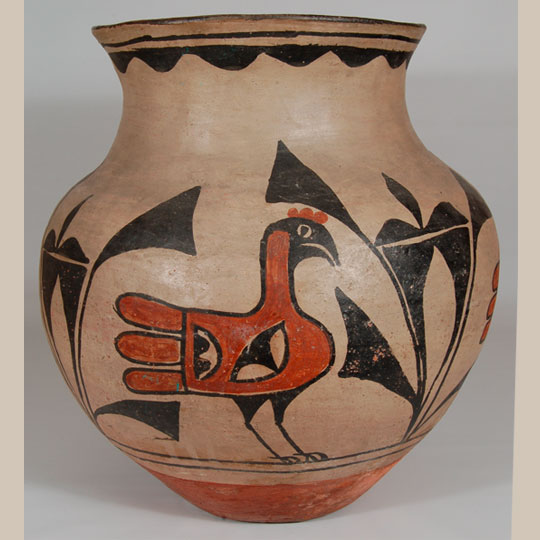 Made circa 1920, this vessel exhibits the classic traits of late Santo Domingo Polychrome. The neck interior is red-slipped, with a black rim top. The under body is stone-polished bare paste with a one-inch rag-wiped red band. The cream/off-white is rag-wiped bentonite slip with black vegetal designs, all of which are broken with one vertically oriented ceremonial break.
Made circa 1920, this vessel exhibits the classic traits of late Santo Domingo Polychrome. The neck interior is red-slipped, with a black rim top. The under body is stone-polished bare paste with a one-inch rag-wiped red band. The cream/off-white is rag-wiped bentonite slip with black vegetal designs, all of which are broken with one vertically oriented ceremonial break.
Most storage jars were made in the 19th Century. Rarely were ones this large made in the 20th Century. Four birds in polychrome design rest on the lower framing lines, and four floral elements complete the design. Below the single framing line at the rim are cloud elements.
Ceremonial Dance with a Deer Dancer and Drummer Painting by Quah Ah - C3868J
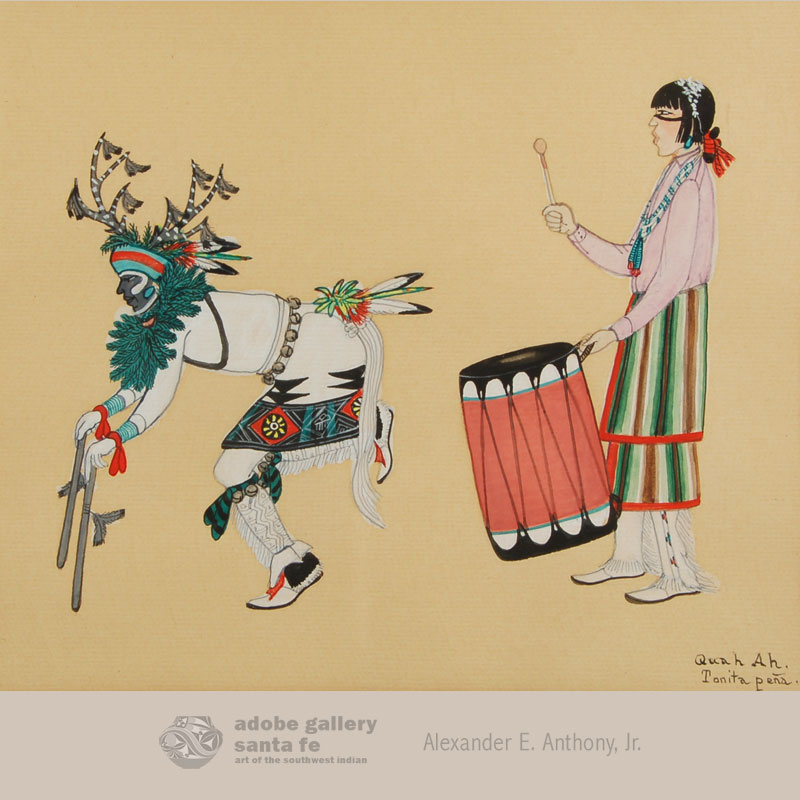 This original painting by Tonita Peña (Quah Ah) of San Ildefonso Pueblo was probably painted in the first two years of the 1920s. Over her career, Tonita used a variety of signatures on her paintings. (A complete description of the signatures and corresponding dates used may be seen in the biographical information provided by clicking here or on her name above.)
This original painting by Tonita Peña (Quah Ah) of San Ildefonso Pueblo was probably painted in the first two years of the 1920s. Over her career, Tonita used a variety of signatures on her paintings. (A complete description of the signatures and corresponding dates used may be seen in the biographical information provided by clicking here or on her name above.)
In this painting, Peña presents a beautiful image of a Deer Dancer in active dance position with his right leg raised in a movement of dance. His deer antler head dress is elaborate with feathers in motion on the antlers. A beautiful green ruff hangs from his neck, eagle feathers bundled together hang from the white rain sash on his back. He wears a beautifully embroidered kilt, white shirt, leggings with yarn ties just below the knees and white moccasin with skunk tied to the backs. In his hands, he carries two sticks that take the place of the deer's front legs.
Keres Pueblo Large Pottery Serving Bowl - C3870B
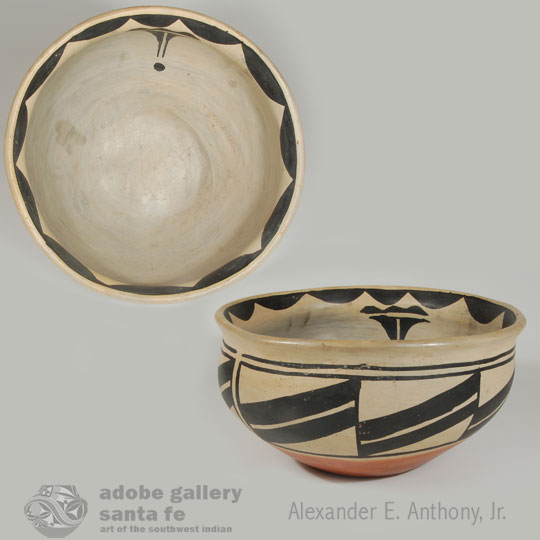 The hesitation in defining the origin of this bowl in the above title is because it is one that could have originated at Cochiti or Kewa Pueblo, therefore we designated it as Keres-the language of both pueblos. The outturned rim is more a feature of Cochiti Pueblo but the strong black on the exterior is more like that from Kewa Pueblo. The single rain cloud on the interior is something that is generally not seen on any Kewa pottery, another fact leaning toward an origin of Cochiti.
The hesitation in defining the origin of this bowl in the above title is because it is one that could have originated at Cochiti or Kewa Pueblo, therefore we designated it as Keres-the language of both pueblos. The outturned rim is more a feature of Cochiti Pueblo but the strong black on the exterior is more like that from Kewa Pueblo. The single rain cloud on the interior is something that is generally not seen on any Kewa pottery, another fact leaning toward an origin of Cochiti.
The Keres Pueblo Large Pottery Serving Bowl is most interesting with the outturned rim, something that sets it above most serving bowls from the Keres Pueblos. The single rain cloud design on the interior is also a unique design not generally seen on such bowls. The potter of this bowl was creative, artistic, and expressive.
Sterling Silver and Turquoise Navajo Bracelet by Stewart Billie - C3864.02
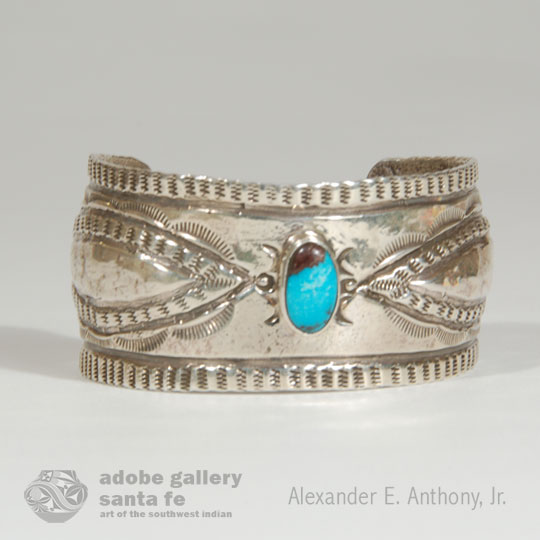 There are several Navajo jewelers with the last name Billie documented in the literature but not one with the first name of Stewart. Most likely, he is a relatively newcomer in the craft.
There are several Navajo jewelers with the last name Billie documented in the literature but not one with the first name of Stewart. Most likely, he is a relatively newcomer in the craft.
The bracelet was beautifully crafted in wide, heavy stock sterling silver. A sky blue turquoise stone is set in the top center and flanked by two long oval designs that were executed in repoussé. The edges of the silver were stamped in wave-like form. The bracelet is beautiful and well crafted.
Navajo Silver and Composite Coral Bracelet - C3864.19
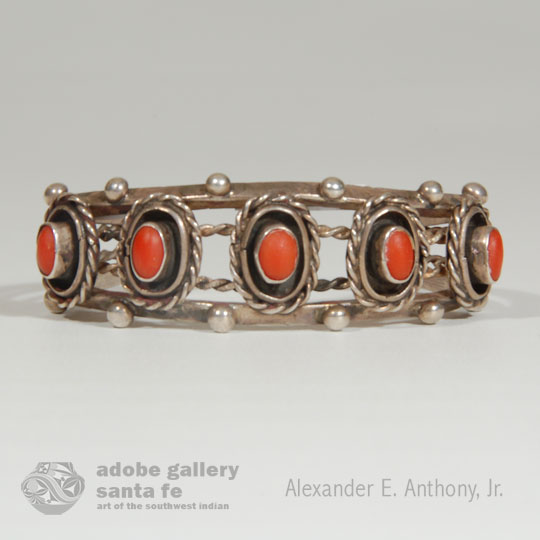 This Navajo bracelet appears to be of the style often made in the 1970s where the jewels were set in a shadow box arrangement. Additionally, the coral appears to be comprised of a mixture of powdered coral and a binding agent. The result is a coral-color setting with a matte finish.
This Navajo bracelet appears to be of the style often made in the 1970s where the jewels were set in a shadow box arrangement. Additionally, the coral appears to be comprised of a mixture of powdered coral and a binding agent. The result is a coral-color setting with a matte finish.
Prehistoric New Mexico Kotyiti Glaze on Yellow Bowl - 25939
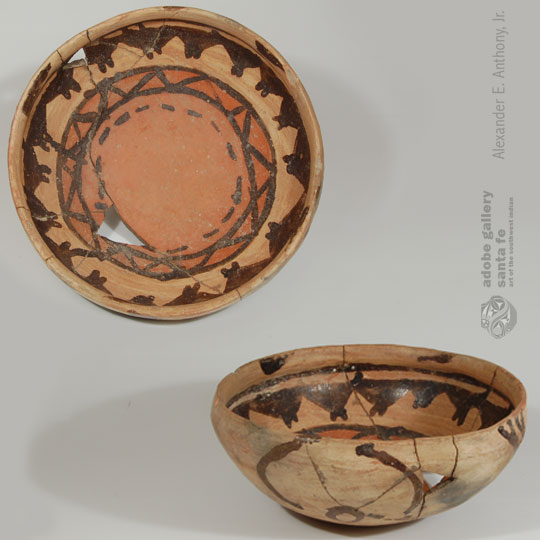 The Galisteo Basin was once home to the Tano Pueblo Indians who were the Southern Tewa. Originally, the Tano lived in the area around Santa Fe. Around 1250 to 1325, they moved further away to the area of the Galisteo Basin, settling in the region at the base of La Bajada, the long descent just south of Santa Fe on Interstate 25. Their new homeland was near Kewa and Cochiti Pueblos.
The Galisteo Basin was once home to the Tano Pueblo Indians who were the Southern Tewa. Originally, the Tano lived in the area around Santa Fe. Around 1250 to 1325, they moved further away to the area of the Galisteo Basin, settling in the region at the base of La Bajada, the long descent just south of Santa Fe on Interstate 25. Their new homeland was near Kewa and Cochiti Pueblos.
The Tano were producing the regular vegetal paint tradition until they switched to the glaze-paint tradition and it, then, became the design of choice. The essential ingredient in glaze paint is lead and the Tano found a ready source of lead near Cerrillos, a short distance from Santa Fe.
The Tano glaze-paint was generally painted on a creamy yellow slip. The glaze paint was not stable and often ran when applied to the surface. It did produce a beautiful shiny black finish which was probably its admirable trait.
Original San Ildefonso Pueblo Painting of a Horse by Oqwa Pi - 25936
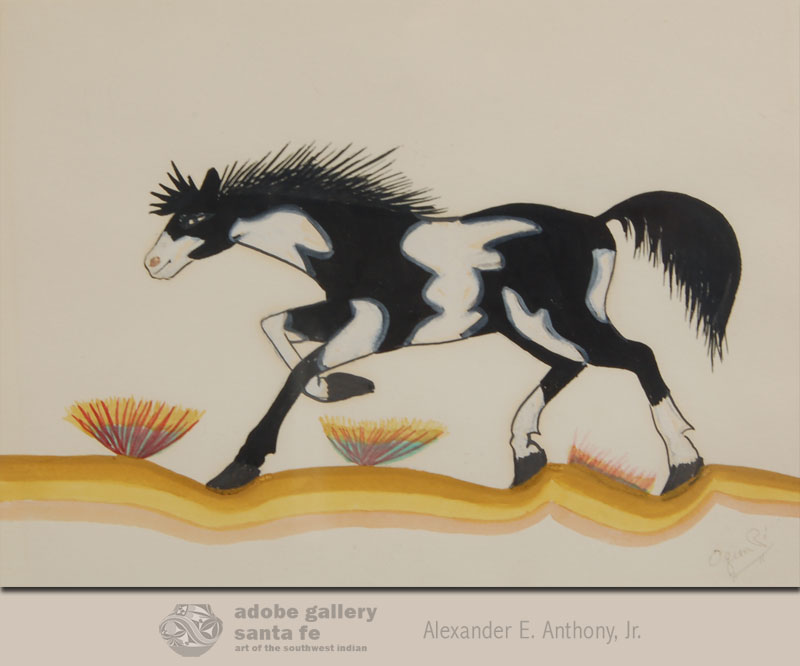 Abel Sanchez was known as Oqwa Pi in the Tewa language. He was the grandfather of San Ildefonso potter Russell Sanchez. Except for what little instruction he received at the Santa Fe Indian School, he had no other formal training. To quote the artist: "I, Oqwa Pi, have been painting since the early 1920s. As I found that painting was the best among my talents, I decided to do my best to win me fame as an Indian artist....as an artist, I have raised a big, healthy family for my painting brought in good income...." Artist's letter to Philbrook Art Center
Abel Sanchez was known as Oqwa Pi in the Tewa language. He was the grandfather of San Ildefonso potter Russell Sanchez. Except for what little instruction he received at the Santa Fe Indian School, he had no other formal training. To quote the artist: "I, Oqwa Pi, have been painting since the early 1920s. As I found that painting was the best among my talents, I decided to do my best to win me fame as an Indian artist....as an artist, I have raised a big, healthy family for my painting brought in good income...." Artist's letter to Philbrook Art Center
Characteristic of Oqwa Pi's style, there are no backgrounds, foregrounds, and minimal ground lines. This tends to make his art charming and true to the folk-art style and certainly true to the Santa Fe Indian School style. The fresh color and action and the great simplicity of his paintings made the works of his well-received in exhibits at the Milwaukee Art Institute, Yale University, Museum of Modern Art in New York City, Stanford University and the Gallery of Fine Arts in Muskegon, Michigan.
Contemporary San Ildefonso Pueblo Black-on-black Dish by Rose Gonzales - C3868H
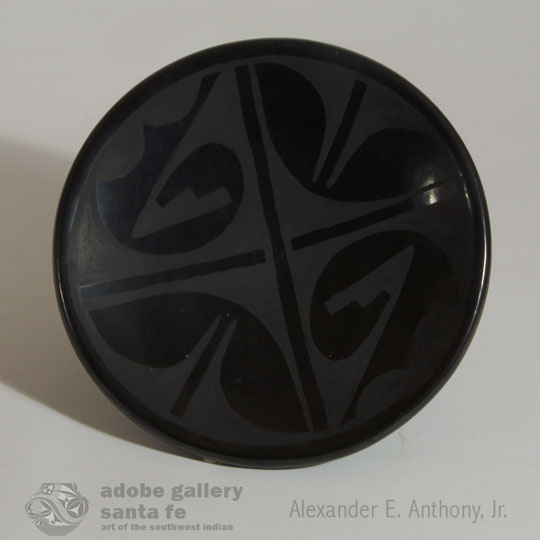 Rose Cata Gonzales was originally from Ohkay Owingeh (San Juan) Pueblo. She married Robert Gonzales of San Ildefonso Pueblo and moved there with him. Rose was a sister of Pomasena Sanchez. She was the mother of Jose H. Rainbird Gonzales, Tse-Pé Gonzales, and Marie Gonzales Yazzie. Rose learned pottery making from Ramona Sanchez Gonzales, her mother-in-law. Rose's parents died from the swine flu epidemic of 1918, leaving Rose and her sister Pomasena orphaned. The girls survived by staying at the Santa Fe Indian School. Mary Cata, a relative, adopted and cared for the girls.
Rose Cata Gonzales was originally from Ohkay Owingeh (San Juan) Pueblo. She married Robert Gonzales of San Ildefonso Pueblo and moved there with him. Rose was a sister of Pomasena Sanchez. She was the mother of Jose H. Rainbird Gonzales, Tse-Pé Gonzales, and Marie Gonzales Yazzie. Rose learned pottery making from Ramona Sanchez Gonzales, her mother-in-law. Rose's parents died from the swine flu epidemic of 1918, leaving Rose and her sister Pomasena orphaned. The girls survived by staying at the Santa Fe Indian School. Mary Cata, a relative, adopted and cared for the girls.
In the 1920s, Rose learned first how to make polished blackware. She then learned the new technique of black-on-black pottery, using a matte black paint for designs. Rose also learned the older technique of black-on-red pottery, most often associated with Tonita Martinez Roybal (1892-1945) and her mother. Rose was credited as the innovator of deep carved pottery around 1930 at San Ildefonso. She sometimes collaborated with her son, Tse-Pé, especially in duotones. She was active as a potter from 1929 to 1989.
San Juan Pueblo Revival Polychrome Carved Jar by Rosita De Herrera - C3870A
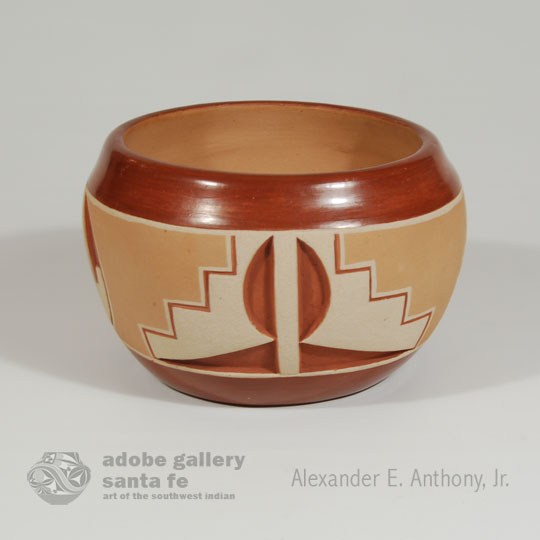 This San Juan Revival Polychrome Carved Jar is an excellent example of the mid-20th century revival style of San Juan pottery. The potter chose rain and cloud designs as her motif for the band surrounding the vessel body.
This San Juan Revival Polychrome Carved Jar is an excellent example of the mid-20th century revival style of San Juan pottery. The potter chose rain and cloud designs as her motif for the band surrounding the vessel body.
Rosita De Herrera and her sister, Dominguita Naranjo, along with their mother, Tomasita Montoya, were the predominant potters producing both styles of revival pottery at the pueblo in the last half of the 20th century. Their pottery was in demand by collectors and dealers.
Happy Katsina Koshare Clown with Watermelon by Fletcher Healing Jr. - C3868B
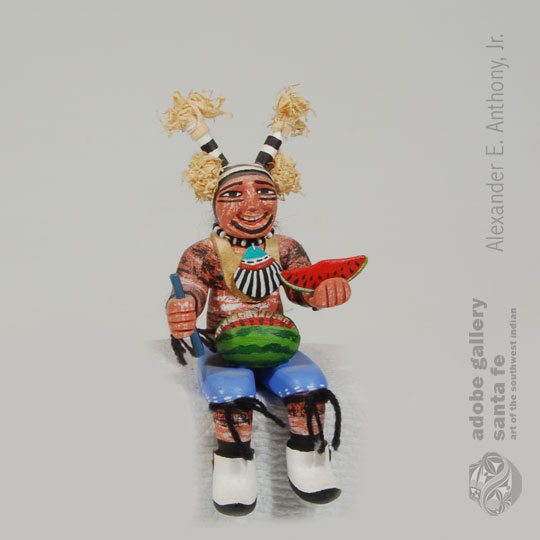 Fletcher Healing, Jr. Hopi-Tewa, Fletcher is the great-grandson of Nampeyo and grandson of Annie Healing Nampeyo. Unlike the rest of the family members, he was not a potter but chose to carve Katsina dolls. He was known for making these seated clowns whose legs hang over from the shelf.
Fletcher Healing, Jr. Hopi-Tewa, Fletcher is the great-grandson of Nampeyo and grandson of Annie Healing Nampeyo. Unlike the rest of the family members, he was not a potter but chose to carve Katsina dolls. He was known for making these seated clowns whose legs hang over from the shelf.

